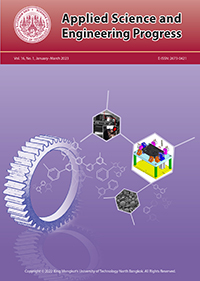Micropropagation and In Vitro Inflorescence of Pentas lanceolata
Main Article Content
Abstract
In this study, different concentrations of 6-benzyladenine (BA) on in vitro shoot and inflorescence inductions of P. lanceolata were investigated. The in vivo and in vitro floral characteristics of this plant were also compared. Nodal explants of P. lanceolata were cultured vertically with the cut ends inserted into semi-solid Murashige and Skoog (MS) medium supplemented with 0, 0.5, 1, 2, 4, and 8 mg L–1 BA. The results showed that the explants formed the highest numbers of shoots even when cultured in MS basal medium without any addition of BA, while the shoots formed in the explants cultured in MS medium supplemented with 1 mg L–1 BA were the longest. No inflorescence was found in the shoots cultured in MS medium supplemented with 8 mg L–1 BA, while the highest percentage of inflorescence induction was found in the shoots cultured in the medium supplemented with 0.5 mg L–1 BA. The apperances of in vivo and in vitro flowers of P. lanceolata were the same in many aspects except that the number of flower/inflorescence formed was different. In addition, water accumulation was observed only inside the in vitro flowers. Water deposit in the long tubular structure of P. lanceolata flower could cause anther injury, suggesting that flowers developed in vitro may not always produce pollen.
Article Details
References
E. F. Gilman and S. Shiffit, “Pentas lanceolata Pentas,” Institute of Food and Agricultural Sciences, University of Florida, Florida, USA, FPS-465, 1999.
C. Puff and V. Chamchumroon, “Non-indigenous Rubiaceae grown in Thailand,” Thai Forest Bulletin (Botany), vol. 31, pp. 75–94, 2003.
J. Schripsema, G. P. Caprini, R. van der Heijden, R. Bino, R. de Vos, and D. Dagnino, “Iridoids from Pentas lanceolata,” Journal of Natural Products, vol. 70, pp. 1495–1498, 2007, doi: 10.1021/np070116.
D. Suman, Y. Vishwanadham, T. Kumaraswamy, P. Shirisha, and K. Hemalatha, “Phytochemical evaluation and analgesic activity of Pentas lanceolata leaves,” Natural Products Chemistry & Research, vol. 2, pp. 135, 2014, doi: 10.4172/ 2329-6836.1000135.
A. Venditti, L. Guarcini, M. Ballero, and A. Bianco, “Iridoid glucosides from Pentas lanceolata (Forssk.) Deflers growing on the Island of Sardinia,” Plant Systematics and Evolution, vol. 301, pp. 685–690, 2015, doi: 10.1007/ s00606-014-1106-9.
C.-S. Lin, C.-T. Chen, C.-C. Lin, and W.-C. Chang, “A method for inflorescence proliferation,” Plant Cell Reports, vol. 21, pp. 838–843, 2003, doi: 10.1007/s00299-003-0571-3.
K. Bodhipadma, S. Noichinda, I. Yadbuntung, W. Buaeiam, and D.W.M. Leung, “Comparison of in vitro and in vivo inflorescence of common cockscomb (Celosia argentea var cristata),” ScienceAsia, vol. 36, pp. 68–71, 2010, doi: 10.2306/ scienceasia1513-1874.2010.36.068.
X.-L. Huang, B. Yang, C.-G. Hu, and J.-L. Yao, “In vitro induction of inflorescence in Dioscorea zingiberensis,” Plant Cell, Tissue and Organ Culture, vol. 99, pp. 209–215, 2009, doi: 10.1007/s11240- 009-9595-x.
T. Murashige and F. Skoog, “A revised medium for rapid growth and bioassays with tobacco tissue culture,” Physiologia Plantarum, vol. 15, pp. 473–497, 1962.
W. Horn, “New types of Pentas lanceolata from seedling progenies,” Acta Horticulturae, vol. 252, pp. 105–110, 1989.
S. Shimizu-Sato, M. Tanaka, and H. Mori, “Auxin–cytokinin interactions in the control of shoot branching,” Plant Molecular Biology, vol. 69, pp. 429–435, 2009, doi: 10.1007/s11103- 008-9416-3.
M. G. Mason, J. J. Ross, B. A. Babst, B. N. Wienclaw, and C. A. Beveridge, “Sugar demand, not auxin, is the initial regulator of apical dominance,” Proceedings of National Academy of Sciences of the United States of America, vol. 111, pp. 6092–6097, 2014, doi: 10.1073/pnas.1322045111.
Z. C. Deng, H. Jin, and H. He, “An efficient micropropagation system for Morinda officinalis How. (Rubiaceae), an endangered medicinal plant,” Journal of Agricultural Science and Technology, vol. 17, pp. 1609–1618, 2015.
S. Anjusha and A. Gangaprasad, “In vitro propagation and anthraquinone quantification in Gynochthodes umbellata (L.) Razafim. & B. Bremer (Rubiaceae)—A dye yielding plant,” Industrial Crops and Products, vol. 81, pp. 83– 90, 2016, doi: 10.1016/j.indcrop. 2015.11.043.
P. Lakshmanan, C. L. Lee, and C. J. Goh, “An efficient in vitro method for mass propagation of a woody ornamental Ixora coccinea L.,” Plant Cell Reports, vol. 16, pp. 572–577, 1997, doi: 10.1007/BF01142326.
S. K. Behera, C. Rajasekaran, S. Payas, D. P. Fulzele, C. G. P. Doss, and R. Siva,“In vitro flowering in Oldenlandia umbellata L.,” Journal of Ayurveda and Integrative Medicine, vol. 9, pp. 99–103, 2018, doi : 10.1016/ j.jaim.2017.02.011.
R. Sreelekshmi and E. A. Siril, “Effect of BA on high-frequency in vitro flowering in Dianthus chinensis L. cultivars- a tool to early screening of variant types,” International Journal of Research and Analytical Reviews, vol. 6, pp. 10–20, 2019.
K. Bodhipadma, S. Noichinda, C. Yompakdee, W. Tamtimdee, U. Chikhuntod, and D. W. M. Leung, “Comparative study of in vitro and in vivo inflorescence of feathered amaranth,” KMUTNB International Journal of Applied Science and Technology, vol. 8, no. 3, pp. 173–177, 2015, doi: 10.14416/j.ijast.2015.06. 001.
G. Aronne, “Effects of relative humidity and temperature stress on pollen viability of Cistus incanus and Myrtus communis,” Grana, vol. 38, pp. 364–367, 1999, doi: 10.1080/00173130050136154.
S. Phanomchai, K. Bodhipadma, S. Noichinda, L. Punnakanta, and D. W. M. Leung, “Effect of different pollen harvesting times on quantity, viability and in vitro germinability of Ixora coccinea ‘Dwarf Red Coccinea’ pollen,” Biotropia, vol. 28, pp. 84–91, 2021, doi: 10.11598/btb.0.0.0.1159.


